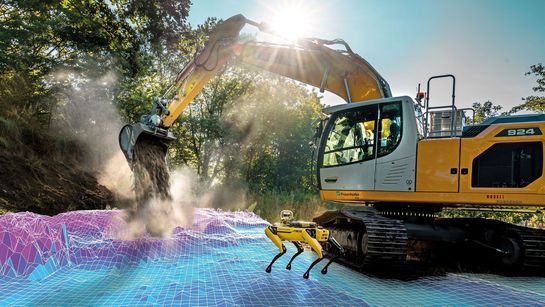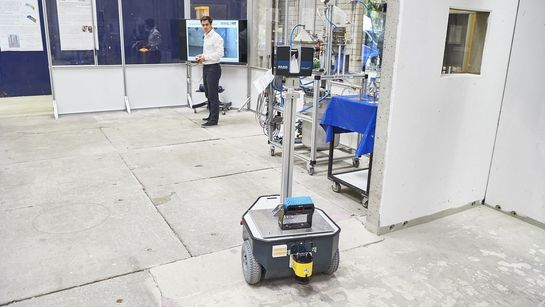The Competence Center »Robotic Systems for Decontamination in Hostile Environments« (ROBDEKON) was funded by the German Federal Ministry of Education and Research (BMBF) as part of the »Research for Civil Security« program. It received around 12 million euros from summer 2018 to fall 2022. ROBDEKON was coordinated by the Fraunhofer Institute of Optronics, System Technologies and Image Exploitation IOSB and also involved the Karlsruhe Institute of Technology (KIT), the Robotics Innovation Center of the German Research Center for Artificial Intelligence (DFKI), the FZI Research Center for Information Technology, and the industrial partners Götting KG, Kraftanlagen Heidelberg GmbH, ICP Ingenieurgesellschaft Prof. Czurda und Partner mbH, and KHG Kerntechnische Hilfsdienst GmbH.
»Our concept was to bundle outstanding competencies from the fields of robotics, remediation of contaminated sites, and dismantling of nuclear facilities as a breeding ground for new ideas. We also wanted to create a central contact point for interested parties and users, and to drive innovations forward in a targeted and practical manner. This has fully proven itself,« summarizes ROBDEKON spokesperson Prof. Dr.-Ing. habil. Jürgen Beyerer, head of Fraunhofer IOSB and the Chair of Interactive Real-Time Systems at the Karlsruhe Institute of Technology (KIT). »In the meantime, we have been able to further develop the teleoperated, semi-autonomous and autonomous demonstrators presented on the occasion of the evaluation in early summer 2021 into system solutions suitable for practical use.«
Here are some highlight technologies developed by ROBDEKON’s research partners:
Fraunhofer IOSB: Autonomy capabilities for heavy construction machinery
One of Fraunhofer IOSB’s focus areas is the automated removal of contaminated soil layers by autonomously operating construction machines. Specifically, the researchers equipped a 24-ton excavator and a tractor with trailer with additional sensor technology and developed extensive autonomy algorithms so that the machines can work in tandem to remove layers of soil and transport the excavated material out of the site.
»Our scope is far beyond simply controlling the equipment remotely,« explains Dr. Janko Petereit, the responsible project manager. »Using a three-dimensional terrain map, we simply specify an area and a certain excavation depth; the systems solve the rest on their own: They find the way, avoid obstacles, carry out the excavation, agree on positioning for loading the material and so on.« A robotic dog can be called in for support, he said, for example, to gather information from other areas or from a different angle. »Technically speaking, we’ve developed and demonstrated solutions for environment mapping, operation planning, and control of construction equipment.«
DFKI Robotics Innovation Center: Automated walking excavator for decontamination in complex terrain
DFKI’s work focused on converting a MenziMuck M545 walking excavator weighing around 12 tons to meet the requirements of two different decontamination scenarios: salvaging toxic barrels and taking soil samples. For this purpose, the researchers equipped the excavator with extensive sensor technology such as cameras and laser scanners. This not only enables it to comprehensively perceive its surroundings, localize itself and autonomously navigate to predefined target points. Controlling the machine is also facilitated by exploiting a variety of sensor data.
Thanks to software developed by the researchers, precise movements, such as those required for sampling, can be planned and executed using the end effector of the excavator’s arm. By automatically adjusting the chassis, an artificial intelligence-based program can ensure the vehicle’s stability even on very uneven terrain. For the barrel recovery scenario, the excavator cooperated with DFKI’s hybrid walking and driving rover SherpaTT, whose task was to explore the terrain and transmit information. Here, a mobile control station set up in the project offered the possibility of combining the findings of both systems and controlling them remotely from a safe distance, even without visual contact.
KIT: Exploration from a safe distance and fully automated decontamination
For the fully automated dismantling of nuclear facilities, contaminated buildings have to be scanned, decontaminated, and measured for clearance. KIT researchers have developed the GammaBot mapping system. It scans interiors and measures radiation exposure. They have also constructed a group of sensors that, mounted on a working platform, automatically measures the contamination of walls. A particular challenge in automated decontamination of plant components is gripping, measuring, and cleaning unknown and heavy objects. The newly developed humanoid robot ARMAR-DE can autonomously grab previously unknown plant components and clean them after an automated scanning process. For safe and intuitive operation of the robots in such hazardous work environments, the researchers have developed telepresence control. This allows humans to control the robot’s movements and work steps from a safe distance using AR/VR glasses or a tablet. The operator should be able to take control at any time to solve problems that the robot cannot solve on its own without prior knowledge.
FZI Forschungszentrum Informatik: Sorting and recovery of hazardous material
The FZI Research Center for Information Technology conducted research on two task scenarios as part of the project. The first involved the development of a demonstrator for sorting hazardous materials by quickly teaching an artificial intelligence. It separates batteries, for example, according to type. The second research focus of the FZI was on the development of partially and fully autonomous force-based manipulation strategies for mobile robots.
In this context, a 3D mapping and navigation framework was developed. With its help, unknown environments can be explored quickly and objects localized. The robot team deployed – consisting of a walking robot and a wheel-driven robot with a gripper arm – can be controlled at a mobile control station using intuitive, task-based controls. »These developments at FZI make the recovery of hazardous materials from unknown environments quick and easy,« says FZI employee Johannes Mangler.
For more information on ROBDEKON’s research topics, use cases, offerings, and publications, as well as on the participating consortium partners and their various competencies, visit the ROBDEKON website, https://robdekon.de/en.
Joint press release of the project partners
Video: ARTER walking excavator and DFKI rover SherpaTT cooperate in barrel recovery scenario






